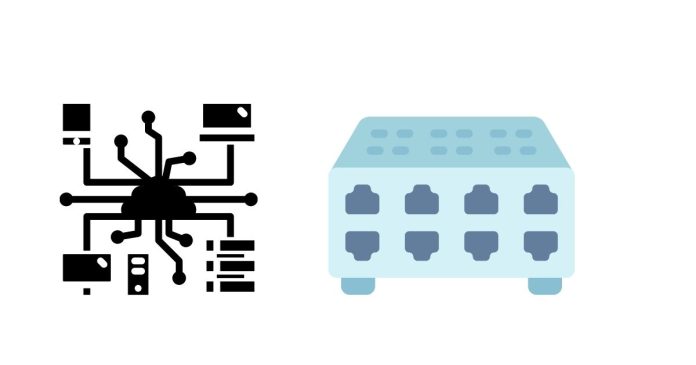In computer networking, switching refers to the process of forwarding data frames or packets between devices within a network. Switching is essential in managing traffic within local area networks (LANs) and wide area networks (WANs), ensuring that data is delivered to the correct destination.
Switching can be broadly categorized into two types based on the layer of the OSI model in which they operate:
1. Layer 2 Switching (Data Link Layer)
Layer 2 switching is the most common type of switching used in modern Ethernet networks. It works at the Data Link layer (Layer 2) of the OSI model and operates using MAC (Media Access Control) addresses. Devices that perform this function are called Ethernet switches.
Key Concepts:
- MAC Address Table (Forwarding Table): Ethernet switches maintain a MAC address table, which maps the MAC addresses of devices to the ports on the switch. This table helps the switch to forward frames to the correct port based on the destination MAC address.
- Frame Forwarding: When a switch receives a frame, it looks at the destination MAC address and forwards the frame to the port associated with that MAC address in the table.
- Broadcasting and Flooding: If the switch does not know the destination MAC address (i.e., it’s not in the MAC table), it will flood the frame to all ports except the one it came from.
- Learning: As frames are forwarded, the switch learns the MAC addresses of the devices connected to its ports and adds them to the MAC address table.
Example:
Suppose a switch receives a frame with a destination MAC address of 00:1A:2B:3C:4D:5E on port 1. The switch will look up the MAC address table and forward the frame to the port where the device with the MAC address 00:1A:2B:3C:4D:5E is connected.
2. Layer 3 Switching (Network Layer)
Layer 3 switching operates at the Network layer (Layer 3) of the OSI model and is also called routing. It uses IP (Internet Protocol) addresses to make forwarding decisions and is typically implemented in devices known as Layer 3 switches or routers.
Key Concepts:
- IP Routing: Layer 3 switches use the destination IP address to route packets across different networks or subnets.
- Routing Tables: A Layer 3 switch or router maintains a routing table that maps network destinations (IP addresses) to the appropriate output interfaces.
- Routing Protocols: Layer 3 switches use routing protocols (such as OSPF, RIP, BGP) to dynamically update routing tables and determine the best path to forward packets.
- Inter-VLAN Routing: Layer 3 switches can also handle routing between different VLANs (Virtual Local Area Networks) in a network.
Example:
When a Layer 3 switch receives a packet with a destination IP address, it checks its routing table and forwards the packet to the appropriate interface based on the best available route.
Types of Switching Methods:
There are different methods of switching based on how data is handled in a network device. The most common ones include:
- Circuit Switching:
- A dedicated communication path is established between two devices for the entire duration of the communication session.
- Commonly used in traditional telephone networks.
- Example: A traditional phone call where a dedicated line is set up for the call.
- Packet Switching:
- Data is broken into small packets, each of which is routed independently from the sender to the receiver.
- It is more efficient than circuit switching, as it allows multiple communication sessions to share the same path.
- Internet Protocol (IP) is based on packet switching.
- Example: Internet data traffic, where information is sent as discrete packets over different paths.
- Message Switching:
- Entire messages are routed and stored temporarily at intermediate points until the next part of the path is available.
- This is less common but used in some legacy systems.
- Example: Some older telecommunication systems.
Switching Technologies:
Switching technology can also vary based on how the switch handles frames or packets:
- Store-and-Forward Switching:
- The switch receives the entire frame before forwarding it.
- It checks the integrity of the frame (using CRC checks), and if the frame is valid, it is forwarded.
- This method introduces some delay but ensures error-free delivery.
- Cut-Through Switching:
- The switch begins forwarding the frame as soon as it reads the destination MAC address, without waiting for the whole frame.
- This reduces latency but may forward erroneous frames.
- Fragment-Free Switching:
- This is a compromise between store-and-forward and cut-through.
- The switch reads the first 64 bytes of the frame (which are enough to detect errors) and forwards the frame if no errors are found.
Key Benefits of Switching:
- Efficiency: Switches reduce the chances of data collisions by creating separate collision domains for each device on a port.
- Scalability: Switches allow easy network expansion and can handle a large number of devices.
- Security: Switches improve security by isolating network traffic between ports and preventing unauthorized access.
- High Performance: Switching ensures high throughput and low latency, especially in Ethernet-based networks.
Conclusion:
Switching is a critical part of computer networking, enabling efficient data transmission between devices in a network. Whether at Layer 2 (Data Link) or Layer 3 (Network), switching helps ensure that data gets from one device to another with minimal latency and error. Understanding the different types of switching and their methods is key to optimizing network performance and reliability.


